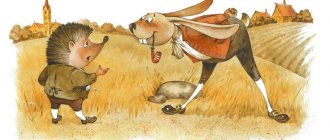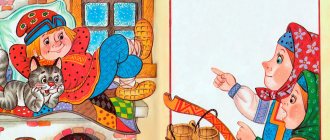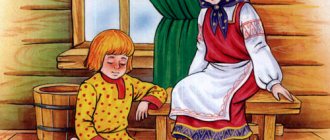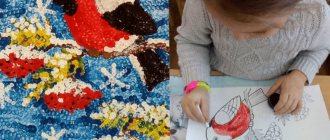A winter tale about a snowman - the main character of the season. The baby will learn why it is important to be friends and try to do everything together. Although this does not always work out, it happens to everyone. Some kids are embarrassed to make new friends. A fairy tale for young children 3 - 4 years old, helps to overcome shyness. They foster a love of nature. Every time of year is wonderful and you can find interesting things to do. There are plenty of winter games to play outside. If it's cold in the evening, there are fun activities you can do at home in the warmth. The snowman talks about this in a fairy tale. Now the baby will not cry if he has to go home from the playground. A fairy tale for children 3-4 years old explains that there is a time for everything. Playing in one place for a long time is boring. Remind your child of the story about the snowman and invite him to go home. Think of something interesting you can do.
Tale about a snowman
It doesn't matter where this story happened. Is it a fairy tale about a snowman or is it true, probably true. It could have happened in any courtyard in the city or on any playground in the village. There were many children on one playground. You look in the summer, and they are there like hares in a clearing: they run, jump, hide from each other, play tag, kick the ball.
But now it was winter, it got dark early, the children went out for walks, gloomy. They make one snowball and ask to go home, crying that it’s cold. They don't want to play. These children walk on their own. They're bored. They don't know how to have fun. Moms and dads ride in sleds, but you still can’t please the kids. And then one day it snowed. There was a lot of snow on the ground, covering the ground with a soft blanket. The children came out in the morning and couldn’t believe their eyes - there was a man made of snow standing in the yard. They had only seen this in pictures.
The body is round, the arms are made of twigs, the nose is a carrot, and there is a bucket on the head. Standing, smiling, holding a broom in his hand. Children surrounded him, looking at him with wide eyes and studying him with curiosity. They stood there for a long time, did not look away, but were afraid to come closer.
— Kids, aren’t you interested in asking who I am? - the little man spoke.
The little ones shook their heads and immediately began to back away. “My name is Snowman,” he smiled at the children, “let’s be friends?” What is your name? “I’m Kirill, and this is Katya,” the bravest boy began. “I’m Daniil, and this is Sasha,” the next one picked up. “I’m Alena, and here’s Vitya,” the girl almost sang.
The rest of the kids also started saying their names.
- How did you get here? - Children made me out of snow. I have been watching you for a long time, when you were flying like snowflakes. I watched how you were afraid to play together. — It’s cold outside and we were shy. — Do you know the best way to stay warm in winter? These are games! And the most fun is to play together. It turns out you knew each other’s names and saw each other in the yard more than once. So let's start being friends now! Here Vitya is holding the sleigh, and Danya took his. You can race children or toys, taking turns changing. Let the start be one football goal, and the finish another. Whoever is faster wins. But the main thing is not to fight or call names. The most important thing is that everyone has fun. Only something is missing... - the Snowman thought thoughtfully - who is watching the competition? - Spectators! - the children answered in unison. - Exactly, let the rest of the kids cheer on our sled racers. - How do they do it? - Shout their names, wish them strength, praise them.
Shout: come on, let's run to the finish line!
The kids competed, ran around, laughed until their cheeks turned red. - How are the kids? Cold? - Nooo! - they shouted back. - Now build me a brother snowman. But smaller, so that he is younger.
The children tried to make 3 circles of a snowman, but it didn’t work. Either one falls apart, then the other does not come together.
- Try to do it together. And let Katya and Alena look for twigs, from which they will later make hands. Instead of an iron bucket, you can put a plastic bucket on it. He's small, let him have a bright hat. And sing a good song, it helps your mood and whiles away the time. I know one that fits, you’ve probably heard it too. And if not, then memorize it.
And the Snowman began to hum the words, and the children picked up:
“White snowflakes have been swirling since the morning, Snowdrifts have grown in the middle of the yard. The street has become brighter from the snowflakes, You just need to dress warmly...”
When the guys united, everything worked out for them. We made three snow circles. They placed them on top of each other according to size: here is the bottom, top and head.
— I thought it would be boring and long, but when you do it with friends, it turns out faster and easier. And it's even more fun when you eat. We weren't cold at all! “Guys,” the Snowman began, “it’s time to say goodbye.” It's getting dark and it's time to go home. “We don’t want to go home, there’s nothing to do there!” - Daniel shouted. — Previously, you thought that there was nothing to do outside in winter. But there are many games: making a snowman, snowballs, skating, sledding, drawing in the snow, building houses. At home, read a fairy tale about me, watch a cartoon about winter. You can make me another brother and put it in your room, in the hall, under the Christmas tree. There are many snowman crafts that you can make yourself. I love when there are Snowmen in yards and in forests and in your warm houses.
The guys went home and waved goodbye to their new snowy friend. Let's go read books about winter and make a snowman craft with our own hands.
What does the snowman symbolize? And what traditions are associated with the snowman?
In the Middle Ages, making snowmen was a way for a community to find some silver lining in a terribly oppressive winter rife with hunger, poverty, and other life-threatening conditions. In 1511, the people of Brussels banded together to build over 100 snowmen in a public art installation known as the Miracle of 1511.
Their snowmen represented dissatisfaction with the political climate, not to mention six weeks of freezing temperatures. The Belgians turned their anxieties into tangible, life-like models: a defecating demon, a humiliated king and women. Besides the typical politically irritated caricatures, Belgian snowmen, Eckstein discovered, were often parodies of folklore characters such as mermaids, unicorns and village idiots.
There was a belief that a snowman made on a full moon could bring misfortune to a person and give him nightmares.
Only in the 19th century were snowmen endowed with good qualities and they entered our lives for a long time as a symbol of the New Year holidays. In the countries of Northern Europe, people made snowmen on the eve of Christmas and as traps for demons: an evil spirit, who mistakenly took the snowman for a person, moved into a pile of snow and could not be freed until spring. Because of this, in Norway snowmen began to be called “white trolls.”
Snowmen with brooms (weapons) were guards of the home, preventing evil spirits from entering.
In Romania, there is a custom to decorate a snowman with “beads” made from garlic heads, as this promotes the health of household members and protects them from vampires, ghouls, and werewolves.
A Christian legend offers an amazing look at snowmen. It says that snow is a gift from heaven, and snowmen are angels. They have the power to convey people’s prayers and requests to God. Therefore, having built a little snowman, you can whisper your most secret things into his ear. And as soon as the winter miracle melted, the wish was delivered to heaven and would certainly come true.
If you believe the old Christian legend, snowmen are equated with angels. After all, the snow from which they are made was given by heaven, which means that snowmen are none other than angels who can convey people’s messages to God, for this they come to earth to find out what and who needs it. So next time do not pass by the snowman, convey a message to the Almighty through him, perhaps he will hear it and in the near future will contribute to what you asked for. This is exactly what they did in ancient times, they made snowmen and quietly whispered their deepest desires in their ears. People believed that as soon as the snowman melted, the wish would definitely be taken to heaven, which means it would soon come true.
Listen to the tale about the snowman
There is another fairy tale about a snowman that you can listen to. Just play the recording for your baby, cover him with a blanket and kiss him goodnight. The baby will listen to a fascinating story while his eyes rest.
A fairy tale about a snowman: listen and imagine.
Listening time: 13:52
Snowman cartoon
And we also have a cartoon about a snowman - a postman. Remember the good childhood hero? Every child dreamed of meeting him and believed that his snowy friend would come to life. In this story, funny adventures await the little viewer. The video is convenient because it is short - your eyes won’t have time to get tired. You can turn it on for your baby before bed after bathing. Get ready for roaring laughter and join in the viewing. It won't take much time. Let's turn off the lights, like in a movie theater, and turn on a cartoon about a snowman and his friends. Children may have already heard this story from V. Suteev’s book “The Christmas Tree”.
The history of the snowman
Bob Eckstein, author of The Story of the Snowman, found the earliest known image of a snowman in an illuminated manuscript of a book from 1380 in the Koninkijke library in The Hague, Netherlands (photo below)
A moody Snowman, sculpted from stacked balls, sits slouched with his back to the deadly fire, the adjacent text reads the crucifixion of Jesus Christ.
It is said that in 1493 Michelangelo Buonarotti, a sculptor and architect, sculpted the first snow figure. But the first written mention of the good snowman is found only in books of the 18th century, and in the 19th century he becomes the hero of fairy tales and often appears on New Year's cards.
In Rus' they also believed in the magical power of snowmen and asked them to reduce severe frosts. But since they believed that snowfalls were controlled by female spirits, they sculpted female snow figures - women - in the courtyards.
Modern traditions with snowmen
In California, every December the Sonoma Valley kicks off the holiday season with the lighting of the Snowman Festival.
That's what Californians do to the decidedly snowless region in winter: wire up hundreds of electric snowmen that appear to march in military formation.
Symbolically, the destruction of the snow effigy may mean the end of the icy months and the tyranny of winter. In Zurich, Switzerland, for example, a giant snowman named Beogg is covered in firecrackers and blown up to the delight of a cheering crowd.
At the Pink Sunday celebration in Weinheim an der Bergstrasse, Germany, the mayor leads a parade through the city, imploring local children to behave obediently to earn the privilege of spring. The children naturally agree, and the townspeople burn the straw snowman. Lake Superior State University appropriated the tradition in the 1970s with its own Snowman Burning Day. Over the years, LSSU's annual four-foot snowman has represented a little more political and social issues, everything they feel needs to be symbolically burned, from sexism and cloning to Ayatollah Khomeini and a rival hockey team.
Everyone's favorite snowmen: from the history of cute creatures
New Years is soon! Yes, yes, it’s just around the corner. And in anticipation of it, ideas and images began to appear in my head, primarily related to interior toys - Father Frosts and Santas, snowmen, elves, gnomes, deer... A sort of round dance of cheerful friends But for some reason it is the snowmen who come to the fore.
Yes, yes, it’s just around the corner. And in anticipation of it, ideas and images began to appear in my head, primarily related to interior toys - Father Frosts and Santas, snowmen, elves, gnomes, deer... A sort of round dance of cheerful friends But for some reason it is the snowmen who come to the fore. Maybe the winter will be snowy? Do not know? Although we, doll and toy makers, do not need snow to create snowmen, but fabric, needles and threads.
Maybe the winter will be snowy? Do not know? Although we, doll and toy makers, do not need snow to create snowmen, but fabric, needles and threads. And, of course, inspiration, which I propose to gain by enjoying a selection of pictures and photographs. I also suggest taking a look at the history page to broaden your horizons.
And, of course, inspiration, which I propose to gain by enjoying a selection of pictures and photographs. I also suggest taking a look at the history page to broaden your horizons.
Some sources report that the first snowman was made by the Italian sculptor and architect Michelangelo Buonarroti in 1493. And who can now say whether this is true, or whether there were still “pioneers” before Michelangelo?
But the first written mention of a snowman is found in a book of the 18th century: it talks about a “beautiful snowman” of gigantic proportions. And the word “schneeman” itself, that is, “snowman”, originally appeared in the German language. The illustration of a snowman also first appeared in Germany, it was published in a children's book with songs, which was published in Leipzig.
You will be surprised, but cute snow creatures were initially considered very evil and feared. The first snowmen were portrayed as fierce, huge monsters that could harm humans. It was also dangerous to build a snowman at midnight, which could be marked by bad dreams and night terrors.
Only since the 19th century did snowmen become kinder, and they began to be identified with Christmas and New Year. Again, according to European legends, snowmen were often mentioned as a means of fighting demons. In Christianity, the snowman was a messenger of heaven, because he was made of snow that just falls from the sky. You could make wishes from the snowman, and when he melted, he supposedly delivered this wish back up into the sky.
It is curious that for Europe there is no difference between a snow woman and a snowman, for both of them they are of the same gender - male. For Russia, there is a clear difference between the sexes.
In Rus', snowmen have been made since pagan times. The snowman was a close assistant of Santa Claus, who was treated with due respect and asked for help. By the way, take the same Snow Woman and Snow Maiden, only we have such. Our ancestors believed that blizzards, fogs, and snows were controlled by female spirits, so they sculpted Snow Women to show them their respect.
In Europe, snowmen were always made next to houses, generously decorated with garlands and household utensils, wrapped in scarves, and given branchy brooms. The mystical nature can be discerned in the details of their “robes”. For example, a nose in the shape of a carrot was attached to appease the spirits who sent harvests and fertility. An inverted bucket on the head symbolized prosperity in the house. In Romania, there has long been a known custom of decorating a snowman with “beads” made from garlic heads. It was believed that this promoted the health of household members and protected them from the mischief of dark forces.
The exact time of the appearance of this tradition in Russia is not known, but apparently, it dates back to pagan, pre-Christian times. This is evidenced, for example, by the custom of sculpting not one, but three snow women at once with the first snow, each of which, according to pagan tradition, was “responsible” for specific problems: the first - for a mild, snowy winter, the second - for the future harvest, and the third, the most little one - they called her Kryshnya - for happiness under the roof of the house. Today, the mystical meaning of snowmen and snow women has been completely lost: they have long become simply a traditional winter pastime, which adults and children indulge in with equal pleasure. Only the obligatory attributes of snow figures remind us of the connection with the past:
1. An old bucket on your head is a symbol of prosperity in the house.
2. Broom - to “drive away” severe frosts and “drive” a lot of snow: then the earth will give birth better.
3. Coals and old household rubbish as facial details are a symbol of getting rid of the past.
4. And the carrot nose is a wordless request for a good harvest.
And only a century and a half ago, Western European snowmen turned into cute hulks - heroes of Andersen's fairy tales and characters in Christmas cards.





